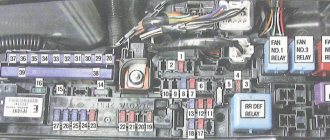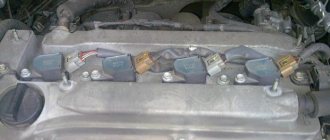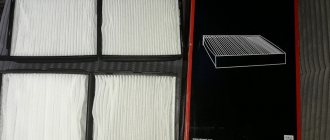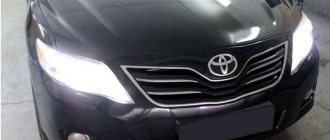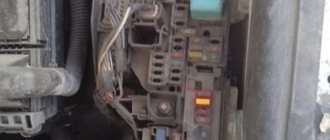The Camry 30 passenger car, belonging to class D, was produced from 2001 to 2006. Modifications with left and right steering were offered (depending on the market). In 2004, the car was modernized (modification XV35). The changes affected the appearance and transmission units.
Dimensions and weight of Toyota Camry
Camry XV30 and XV35 cars were produced only with 4-door sedan bodies and had the following overall dimensions and weight:
- wheelbase - 2720 mm;
- front and rear wheel track - 1550 and 1535 mm, respectively;
- ground clearance - 150 mm;
- length - 4815 mm;
- width (with mirrors removed, on the sides of the doors) - 1795 mm;
- height (excluding antenna) - 1500 mm;
- curb weight (depending on the type of engine and transmission) - from 1390 to 1520 kg;
- permissible total weight - from 1935 to 2015 kg.
Body capacity
The interior of the car is designed to carry a driver and 4 passengers. The front seats have separate seats equipped with manual adjustment mechanisms. An optional driver's seat with electric drives is available.
At the rear there is a sofa with a split folding backrest, which allows increasing the capacity of the luggage compartment.
The trunk has a minimum capacity of 587 liters. The lid hinges are covered with side trims, which prevents damage to luggage from metal parts when locking the compartment.
Appearance of Camry 30
The car is equipped with a sedan body with plastic voluminous bumpers that prevent damage to metal structural elements in a collision at speeds of up to 10 km/h. The doors are equipped with a protective plastic lining, painted in the main color of the car. The rear lighting equipment is larger in size: the lights partially extend onto the sidewalls of the wings. The metal panels are galvanized and additionally coated with a layer of protective primer. The manufacturer provided a 12-year guarantee against through corrosion.
The fuel tank hatch is located on the driver's side of the rear fender and has a remote-controlled lock. The capacity of the fuel tank, located in a niche under the rear sofa, is 70 liters, and does not depend on the type of drive. On cars in basic modifications, 16-inch stamped wheels with decorative caps were used, on improved versions - light alloy wheels (with tire size with a road tread pattern of 215/60R16).
The standard equipment of the cars included fog lights installed in the front bumper. The default headlights used xenon lamps to improve road illumination. Ultrasonic parking sensors were installed in the bumpers (optional), information about the distance to the obstacle was displayed on the screen of the standard radio.
Toyota Camry XV30 interior
Foamed plastic with a soft surface was used in the interior decoration. The center console and door cards had decorative plastic overlays coated with a coating that imitated valuable wood. In the standard version, the chairs are covered with natural fabric; in expensive versions, leather is used. In the rear sofa there is a folding armrest with 2 cup holders. For the driver and front passenger there is a central armrest, under which there is a niche for storing small appliances.
The steering wheel has an airbag (there are also buttons for controlling the multimedia center). An analog instrument cluster with adjustable backlight is used. The steering column is manually adjustable for angle and reach, and the radio is included as standard equipment (navigation unit with the ability to update maps).
The central part of the dashboard contains an air conditioning control unit and buttons for turning on auxiliary systems.
Specifications
The standard equipment of the vehicles includes airbags installed in the instrument panel and in the backs of the front seats (curtains are available on request).
Inertial seat belts are used for the driver and passengers; pyrotechnic pretensioners with force limiting mechanisms are used at the front. The braking system (disc type for front and rear wheels) is equipped with an anti-lock braking unit with electronic brake force distribution and emergency braking assistant.
Main technical parameters of the car (for modification with a 2.4 liter engine and automatic transmission):
- working volume - 2362 cm³;
- torque - 218 N/m at 3800 rpm;
- power - 152 hp. With. at 5600 rpm;
- compression ratio - 9.6;
- fuel type - gasoline with an octane rating of at least 95;
- turning diameter - 10.6 m;
- maximum speed - up to 200 km/h;
- acceleration time from zero to 100 km/h - 10.5 seconds;
- average fuel consumption - 7.6 liters per 100 km;
- Fuel consumption in the city is at least 13.2 liters per 100 km.
The manufacturer allowed the installation of a towing device for mounting a trailer. The permissible weight of a trailer without a brake system is 500 kg. When using brake mechanisms, the parameter increases to 1600 kg, but at the same time the dynamics decrease and gasoline consumption increases.
To reduce the load on the steering wheel, a hydraulic booster is used (the gain decreases with increasing speed).
Reviews
Dear Readers, share your opinions and Camry 30 rating in the comments.
Thank you.
Reviews from real Camry 30 drivers presented below are taken from the website drom.ru.
Opinions of real drivers about the Camry 30 with a 2.4 engine
Click to enlarge
Reviews of Camry 30 with 3.0 engine
Click to enlarge
Engine power and transmission
The company produced several modifications of the Toyota Camry XV30, which differed in engine size and transmission design:
- The basic version was equipped with a 150-horsepower 1AZ-FE gasoline engine with 4 cylinders (volume 2.0 l). The cars were supplied only with a 4-speed hydromechanical gearbox and front drive wheels.
- The modification with a 2.4-liter 2AZ-FE unit had a power of 152 hp. With. Cars were offered with a 4-speed automatic transmission, transmitting torque to the front wheels. A 4WD modification with all-wheel drive was assembled in small batches. After restyling in 2004, some cars began to use a 5-speed automatic transmission. There was also a version with a 5-speed manual transmission and front-wheel drive.
- Version with a 186-horsepower V-shaped 6-cylinder gasoline unit 1MZ-FE with a volume of 3.0 liters, which worked in conjunction with a 4-speed hydromechanical gearbox. Later, variable valve timing VVT-i was introduced into the engine design, which increased power to 210 hp. With. Since 2004, the 3MZ-FE engine with a power of 225 hp has been offered on the American market. With. (volume 3.3 l, with VVT-i system), which was equipped with a 5-speed automatic transmission.
Price
The cars are still available on the secondary market, and you can find a live copy. They sell them for 360-500 thousand rubles. As you understand, the condition of the body depends on the price. A little expensive, not everyone is ready to afford to buy such an old car for that kind of money. Maintenance is cheap, unless of course you buy a contract motor every time.
Conclusion: The Toyota Camry XV30 is still a reliable Japanese car that will delight its owner with comfort for a long time if it is taken care of. There are disadvantages to it, but there are many more advantages - after all, it’s already a legend.
Frequent malfunctions
To drive the gas distribution mechanism in in-line 4-cylinder engines, a chain is used that can withstand a mileage of more than 300 thousand km. In V-shaped engines, the camshafts are rotated by a toothed belt, which must be changed along with tension and additional rollers every 150 thousand km. When the belt breaks, the valve plates come into contact with the piston heads. To restore functionality, a partial overhaul of the engine will be required.
To drive attachments (generator, air conditioning compressor), a poly-V-belt is used, which is destroyed under the influence of dust and temperature changes every 60-80 thousand km. The design uses an automatic tension roller; when the bearings fail, an extraneous sound appears with a variable pitch (depending on the crankshaft speed).
The exhaust system uses catalytic converters with sensors that detect oxygen concentration. If the sensor heating system spiral breaks, the Check Engine indicator turns on in the instrument cluster. To restore functionality, it is necessary to replace the sensor or install an additional resistance in the circuit (simulating a heating coil). It should be borne in mind that this technique is suitable for motors of the 2AZ-FE series: on 1AZ-FE motors, setting the resistance does not eliminate the error indication.
During operation, a coating of dirt forms on the surface of the throttle assembly and air flow sensor, which negatively affects engine performance. To remove deposits, it is necessary to wash the parts every 40-60 thousand km. The ignition system uses platinum-coated spark plugs. It is recommended to replace parts after 30-40 thousand km. When using worn spark plugs, the load on the ignition coils increases and they fail.
The hydromechanical box uses a special fluid. If jerking occurs when switching, the old oil must be drained. The fluid is replaced in a garage or at a service center. In manual transmissions, the friction linings of the clutch wear out, the rate of destruction of which depends on the operating conditions of the vehicle. The engines have a service life of more than 500 thousand km. If oil consumption is increased and smoky exhaust appears, you should check the compression and change the oil seals and piston rings.
The disc brakes in the rear wheels become clogged with dirt, causing the guides in the caliper to jam. Due to constant contact between the pad and the disc, accelerated wear of parts occurs and heating of the hub occurs. The repair consists of disassembling the unit, removing dirt and replacing worn components (the original lubricant is applied to the guides). If a hum occurs while driving, varying depending on the direction of rotation, you will need to check and replace the wheel bearings.
What difficulties might the current owner encounter?
The chrome of the radiator grille is not durable, it does not like salts and reagents. Over time, on Toyota Camry 2001-2006. produced for the American market, the headlights become cloudy. This problem is solved by replacing the plastic protection with glass from the “European” thirty. The electric drives of the antenna and folding mirrors fail; cleaning the mechanisms will not help for long.
Camry 30 before restyling
Window regulators often break; the mechanism only needs to be replaced completely. The air conditioner has been on for a while, but it’s still hot – the fan, or rather its relay, has failed. The age and difficult conditions of use of the car will lead to radiator leaks, to delay this breakdown, wash the radiator once a year and change the antifreeze every 30 thousand km.
The front brake discs can easily wobble when driving through a puddle after hard braking; they often have to be changed every 30 thousand km. Every time you replace the pads, clean and lubricate the caliper guides; if this is not done, the mechanism may jam.
Camry 30 after restyling (spoiler is an attribute of the SE configuration)
Camry cost 30
The car appeared on the European market in the fall of 2001, but the car did not become popular. A used “European” will cost the buyer from 315 thousand rubles, the cars have a mileage of 180 thousand km and more. The version for the Japanese domestic market with right-hand drive has a cost of 400 thousand rubles. and features improved equipment. Modifications for the North American market (the main sales region of the Camry XV30) can be found for 370 thousand rubles, the “American” will have a mileage of 150 thousand miles (equivalent to 250 thousand km).
Suspension
The creators of the 2002 Toyota Camry did not try to find a compromise between handling and comfort. They relied on a soft, energy-intensive suspension, the car does not drive, but floats along the road, without noticing any potholes or bumps. The downside is body roll even when changing lanes, not to mention sharp turns, and nose dive when braking.
In addition to impressiveness, a feature of the Camry XV 30 suspension is its legendary reliability.
Stabilizer bushings travel at least 40 thousand km with a heavy V6 engine and more than a hundred with a four-cylinder. Ball joints and silent blocks of the front levers will last 200 thousand.
The bushings of the rear longitudinal rods travel 150 thousand km, and the transverse rods even longer.
Restyling Toyota Camry 30
After restyling, modified headlights and taillights began to be used on the car. The dimensions remain the same, but the outlines of the decorative radiator grille and front bumper have changed, and the configuration of the fog lights has also changed. The strength frame and door panels remained unchanged, but amplifiers appeared in the design. Cars of early versions were equipped with a body brand ACV30L, after modernization the code changed to MCV30L (sometimes Camry cars produced after 2004 are classified as the intermediate generation XV35).
Comparison with competitors
The main competitors of the Camry 2004 at the moment will be the Japanese sedans Mazda 6 of the first generation (GG), Honda Accord (CL) and Ford Mondeo of the third generation. The advantage of these cars is that they are station wagons. They will also handle much better than the Toyota Camry 30, but you won't experience the same smoothness and softness in either of them. Comparison of exteriors is unnecessary: taste and color... The attractiveness of interiors at the moment depends more on the condition than on the original appearance.
Leather interior Camry 30
The reliability of the three Japanese cars is comparable, with Ford being the underdog in this regard. The Mondeo was equipped with many different engines, but the two 1.8 and 2 liter petrol engines that it got from Mazda were unpretentious. The undeniable advantage of Toyota is its status; Mazda and Honda of those years are associated with sports and drive. They are a favorite of street racers and have often been modified to make them more aggressive.
